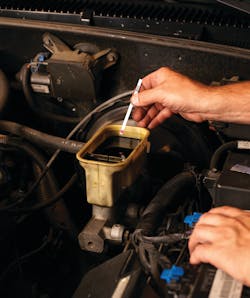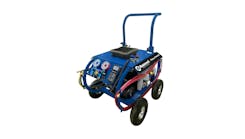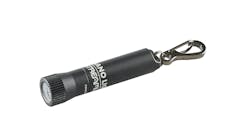Direct Hit: 409593
Vehicle Application: 2005 Mazda 6
Average Reported Mileage: 63,000
Customer Concern: Came in with the brakes locking up and smoking brake pads. The left front caliper was frozen and had a collapsed brake hose. After replacing those parts, the same problem returned.
Tests/Procedures: Separate the master cylinder from the brake booster and determine if the master cylinder piston may be hanging up and not returning all the way. If so, the master cylinder is faulty. This usually happens as the result of brake fluid contamination.
Tech Tips: These models are known to suffer brake fluid contamination. If brake fluid has turned green, flush the system to prevent further complications.
Tools used:
- Brake pressure test gauge/test kit
- Brake fluid pressure bleeder/flush tool
- Brake fluid testers
Contaminated brake fluid
Brake fluid contamination is more common than most techs or their customers realize. Brake fluid contains alcohol, and it absorbs moisture even in a sealed system. Seams in the steel brake line are brazed with a copper alloy, and as moisture content in the brake fluid increases, the copper corrodes and dissolves in the fluid. Over time it attacks the rubber seals, and tiny passages may become clogged as the rubber deteriorates. This is why many car manufacturers recommend flushing the brake fluid semi-annually.
Two different tools are used to check for contamination; test strips and an electronic conductivity tester. Test strips are chemically treated slips of absorbent paper that turn different colors in the presence of copper. Brake fluid naturally darkens over time in the system, but that tells you little about its condition. The chemically treated test strips are far more reliable. They’re also an inexpensive and convincing sales tool.
An electronic conductivity tester costs a bit more, but it’s a sales tool that can help avoid brake fluid contamination. Instead of detecting dissolved copper, it measures the moisture content in the brake fluid. If the fluid is tested regularly and changed when moisture is above acceptable limits, the problem experienced in this Mazda might have been avoided. Using a conductivity tester is easy; just dip the probe into the fluid reservoir and read the meter.
An optical refractometer will also show the water content in brake fluid. It’s inexpensive, simple to use and perfectly reliable. Since only two drops of fluid are needed for testing, a refractometer can be used to sample brake fluid from both the reservoir and the caliper/wheel cylinder.
Brake fluid flushing
There are several different tools for flushing a hydraulic brake system. On most Anti-lock Brake Systems (ABS), the valves must be commanded open to flush all the old fluid from the valve body. A bi-directional scan tool that communicates with the ABS control unit will do the job. However, even if you can’t open the ABS valves, a fluid flush will still change over 95% of the fluid in the system.
Pressure bleeders and brake flush machines work by forcing clean brake fluid through the system from the fluid reservoir all the way down through each open bleeder. Some use an electric pump, some use shop air, but either way the pressure must be regulated to avoid damaging seals and valves. Typically, about 30 psi is enough, although higher pressure is required on some hybrid vehicles. The job usually takes about ten minutes, but with set-up time it’s easy to justify charging an hour of labor.
A vacuum bleeder sucks fluid out of the system through the bleeder valve at each caliper/wheel cylinder. It’s powered by shop air and uses a flow eductor to create a vacuum on the fluid collector bottle (see sidebar). The only real trick to using this tool is to check the fluid reservoir often. If all the fluid runs out, air is sucked into the system and you have to start all over again. A hand-operated vacuum pump with a fluid collection bottle can also be used to bleed or flush a brake system. Those tools are inexpensive and easy to use, but the job takes more time.
One company offers a unique tool that fills the brake system from the bottom up. Phoenix Systems makes several versions of a hand-operated pump that “injects” brake fluid into the caliper or wheel cylinder through the bleeder. This offers several options. Instead of forcing fluid up to the master cylinder, you can open the other brake bleeder on that circuit and force new fluid through just that part of the system. Repeat on the other circuit, then empty the reservoir and inject new fluid through any bleeder. The company says this will force any air in the system to go where it would naturally go anyway; up. They also emphasize that this is not the way to flush a brake system because it doesn’t flow enough fluid to wash away contaminants in the system. Still, on brake systems that are difficult to bleed, this technique may be the answer.
Pressure test
Whenever there’s a hydraulic problem, especially a seized caliper, it’s important to check hydraulic pressure at each wheel. There are two different ways to do this; with pressure gauges threaded directly into the hydraulic system or with caliper pressure gauges.
Hydraulic gauges with adapters can be threaded directly into the brake bleeder ports. To get an accurate reading, the gauges must be bled too. Caliper pressure gauges have a pressure sensor that fits into the caliper in place of the brake pads. These save lots of time and brake bleeding, but if the rear axle has drum brakes, you’ll still need hydraulic gauges to check those pressures.
Rear brake pressure will always be lower than the front, but pressures should be equal side-to-side on each axle. Pressures at each side should also rise and fall together. If there’s a difference between left and right brake pressures, swap the gauges to check their calibration. Vehicle height sensors or height-sensing pressure limiting valves can also cause different left/right brake pressures.
On the Mazda described earlier, the collapsed brake hose caused pressure on the left caliper to rise and fall slower than on the right. If the master cylinder was clogged, left side pressure probably wouldn’t release when the pedal was released. One way to diagnose this is to remove the master cylinder as suggested. But tools that measure brake pressures and test the condition of the fluid not only save diagnostic time, they also produce solid information that will help determine the proper repair and help sell it to the customer.
NOTE: A flow eductor is a jet pump with no moving parts. Instead it uses the venturi effect to create a vacuum. Picture a tube with a restriction in the middle, an input fitting at one end and an inlet port next to it. As the “motive” air or fluid is forced through the input fitting, pressure in the tube increases upstream of the restriction. But once past the restriction (throat), pressure in the output side of the tube falls even lower than the pressure on the input side. This creates a vacuum at the inlet port that will suck additional air or fluid through the port. There are several automotive applications, including fuel transfer pumps, shop blow guns and a vacuum brake bleeder.



